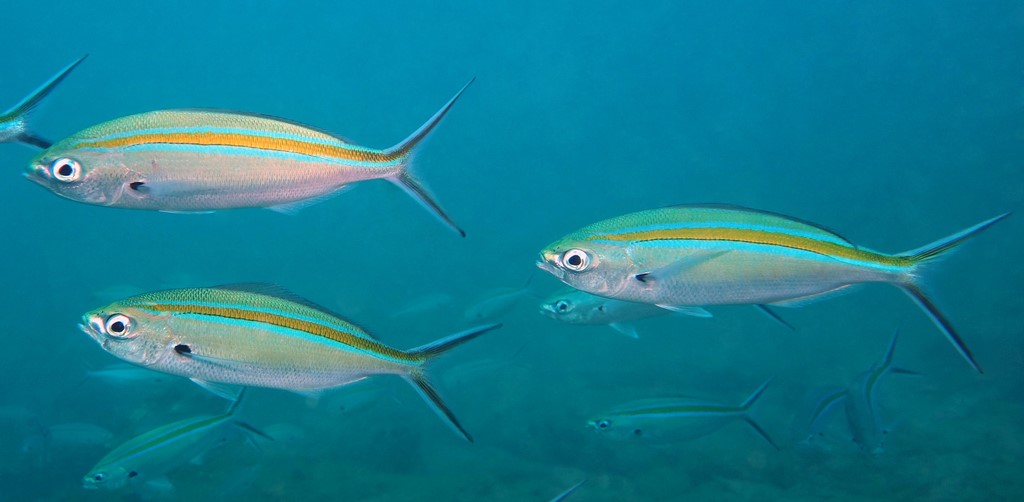CAESIO CAERULAUREA - (LACEPEDE, 1801)
Picture courtesy of: Yves Thévenet
Actinopterygii (Gigaclass) > Actinopteri (Class) > Teleostei (Subclass) > Lutjaniformes (Order) > Lutjanidae (Family) > Lutjaninae (Subfamily) > Caesio (Genus)
Fusilier à bande dorée, Fusilier bleu et or, Blue and gold fusilier, Blue fusilier, Gold-band fusilier, Gold-banded fusilier, Goldband fusilier, Scissor-tail fusilier, Scissortail fusilier, Blou-en-goue piesangvis, Kalmooh, Blåog guldbåndet musketerfisk, Caesio azuror, Saneera, Sasamuro, Fuzileiro azul, Fusilero azur, Shimamuro-gurukun, ササムロ, بُنْدُقية سماوِية, 乌尾鮗, 褐梅鲷, 褐梅鲷, 乌尾冬仔, ปลาเหลืองปล้องหม้อ, Cá Miền vàng xanh,
Synonymes
Caesio azuraureus (Rüppell, 1830)
Caesio caerulaureus (Lacepède, 1801)
Caesio cearulaurea (Lacepède, 1801)
Caesio coerulaureus (Lacepède, 1801)
Caesio maculatus (Cuvier, 1830)
Caesio nori (Montrouzier, 1857)
Smaris mauritianus (Quoy & Gaimard, 1824)
---------------------------
Description
Dorsal spines (total): 10; Dorsal soft rays (total): 14-16 (usually: 15); Anal spines: 3; Anal soft rays: 12-13 (usually: 12); Pectoral fin rays: 19-22 (usully: 21); Lateral line scales: 57-65 (usually: 58-63); Scales on cheek: 3-5 (usually: 4); Predorsal scales: 22-25; Dorsal and anal fins scaled. Supra-temporal band of scales often interrupted by a V-shaped scaleless zone anteriorly at midline. Upper peduncular scale rows: 10-12 (usually: 11); Lower peduncular scale rows: 14-15 (usually: 15). A small process on each ventrolateral surface of basioccipital for attachment of Baudelot's ligament, a prominent concavity on ventral surface of basioccipital separating it from condyle. Post maxillary process single; Posterior end of maxilla blunt. Head length: 2.7-3.4 in SL; Body depth: 3.0-4.2 in SL. Max. length: 35.0 cm TL, common length: 23.5 cm SL. Depth range: 1 - 50 m.
Color
Upper body bluish, lower white to pale bluish; A single yellow or golden stripe directly above lateral line except on caudal peduncle where it is about one scale above lateral line, the yellow stripe 2-3 scales wide, bordered directly above and below by a white or light blue stripe which is about one scale wide, caudal-fin lobes with a black median streak.
Etymology
Caesio: from Latin, caesius = blue-grey or bluish-grey. Referring to upper body of Caesio caerulaurea, described as a “sky blue most pleasant to the eye”.
caerulaurea: from Latin, caeruleus = dark blue, dark green, cerulean, azure + from Latin, aureus = golden, gold. Referring to color of upper body.
Original description: Caesio caerulaurea Lacepède, 1801 - Type locality: Molucca Islands, Indonesia.
Distribution
Red Sea; Indo-West Pacific: Aliwal Shoal (South Africa), East Africa, Socotra (Yemen), Seychelles, Comoros, Mozambique Channel, Madagascar and Mascarenes (La Réunion, Mauritius, Rodrigues) east to Marshall Islands, Tuamotu Archipelago and Marquesas Islands (French Polynesia), north to Amami Islands (southern Japan), south to off northwestern Australia, Queensland (Australia), New Caledonia and Tonga.
Caesio: from Latin, caesius = blue-grey or bluish-grey. Referring to upper body of Caesio caerulaurea, described as a “sky blue most pleasant to the eye”.
caerulaurea: from Latin, caeruleus = dark blue, dark green, cerulean, azure + from Latin, aureus = golden, gold. Referring to color of upper body.
Original description: Caesio caerulaurea Lacepède, 1801 - Type locality: Molucca Islands, Indonesia.
Distribution
Red Sea; Indo-West Pacific: Aliwal Shoal (South Africa), East Africa, Socotra (Yemen), Seychelles, Comoros, Mozambique Channel, Madagascar and Mascarenes (La Réunion, Mauritius, Rodrigues) east to Marshall Islands, Tuamotu Archipelago and Marquesas Islands (French Polynesia), north to Amami Islands (southern Japan), south to off northwestern Australia, Queensland (Australia), New Caledonia and Tonga.
Biology
Inhabits coastal areas, primarily around coral reefs. Found in schools in deep lagoons and along seaward reefs, mixing with other species of fusiliers. Juveniles used as tuna bait fish. Oviparous, with small pelagic eggs.
Inhabits coastal areas, primarily around coral reefs. Found in schools in deep lagoons and along seaward reefs, mixing with other species of fusiliers. Juveniles used as tuna bait fish. Oviparous, with small pelagic eggs.
Similar species
Pterocaesio chrysozona (Cuvier, 1830) - Reported from New Caledonia.
Pterocaesio tile (Cuvier, 1830) - Reported from New Caledonia - Link to the species (here).
Pterocaesio chrysozona (Cuvier, 1830) - Reported from New Caledonia.
Pterocaesio tile (Cuvier, 1830) - Reported from New Caledonia - Link to the species (here).
Caesio xanthalytos (Holleman, Connell & Carpenter, 2013) - Reported from Western Indian Ocean: KwaZulu-Natal (South Africa) north to Kenya, east to northwestern Madagascar.
Last update: 17, December 2022
